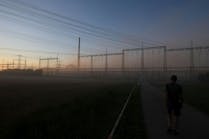Co-Recipients to Receive Sarbanes Award at CFSI Dinner
The Congressional Fire Services Institute (CFSI) and National Fallen Firefighters Foundation (NFFF) have selected the Florida Firefighters Safety and Health Collaborative and the Denver Fire Department as the co-recipients of the Senator Paul S. Sarbanes Fire Service Safety Leadership Award.
The award will be presented at the 31st Annual National Fire and Emergency Services Dinner on April 25, 2019, in Washington, DC. Named after retired-Senator Paul S. Sarbanes of Maryland, a strong advocate for our nation's firefighters and rescue personnel during his 36-year career in Congress, the award recognizes organizations for outstanding contributions to firefighter health and safety. State Farm Insurance and VFIS serve as the corporate supporters of the award program.
The Florida Firefighters Safety and Health Collaborative brings together members of the fire service and health and safety advocates in the state of Florida to share information and best practices on firefighter health and safety. Firefighter cancer prevention, emotional and mental wellness, health and physical fitness, and safety at all emergency incidents are the key focus areas of the program.
The Denver Fire Department Safety and Training program incorporates fitness, nutrition and behavioral health that can be tailored to the needs of each individual firefighter. The elements are integrated with the department’s safety and training program, beginning with the recruit level and continuing well into each firefighter’s career.
CFSI President Bill Jenaway and NFFF Chairman Dennis Compton issued a joint statement recognizing the 2019: “We are witnessing dramatic changes in the fire service on the issue of health and safety—changes inspired in part by firefighters at the local level who are passionate about making the profession safer. We commend both the Florida Firefighters Safety and Health Collaborative and the Denver Fire Department for the establishment of two successful health and safety programs. What makes these programs successful is the collaboration and cooperation of so many individuals at the local level who care deeply about the health and safety of their fellow first responders. We look forward to honoring both organizations at the 31st Annual National Fire and Emergency Services Dinner.”
For additional information about the event, or to register to attend, visit cfsi.org/2019-dinner/event-information.
Registration Open for NFPA Conference & Expo
Registration is now open for the 2019 NFPA Conference & Expo, which will be held June 17–20 at the Henry B. Gonzalez Convention Center in San Antonio, TX. The event includes more than 130 education sessions, a First Responder Health & Wellness Forum, the NFPA Technical Meeting, and an exhibition hall featuring products, NFPA experts and more.
The NFPA Technical Meeting, also known as “Tech Session,” is an important element in the standards development process, ensuring that consensus is achieved on proposed changes to NFPA Standards prior to Standards Council review. During this meeting, supporters and opponents of certified motions voice their opinions and qualified NFPA members vote on proposed changes.
To register, visit nfpa.org/conference/register.html.
Letter to the Editor
Firehouse received multiple comments on the December issue Fire Scene column “Victim Survivability Profiling” by Battalion Chief (ret.) John Salka. Following is an excerpt from one Letter to the Editor, written by Stephen Marsar, author of the survivability profiling concept.
Firefighters who have been raised in aggressive interior firefighting departments fear that survivability profiling tells them that interior attack, search and rescue is no longer warranted, but that could not be further from the truth.
In your article, you described survivability profiling as “a process whereby we (the members of the fire service) can examine a building that is on fire and actually come up with an answer to the eternal question, is anyone in there?” As you well know, that question is a basic tenant of size-up. Survivability profiling goes beyond size-up and asks, “Are people ALIVE in there?” And if they’re not or if they may be alive, let’s get water on the fire—which makes everything immediately start to improve—and find them. As you say, “get in there.” In smaller and/or understaffed departments that don’t have the luxury of several engine companies to protect searching members, “getting in there” may best be accomplished by the stretching and operating of a hoseline on the fire first, and then conducting the searches.
Yes, civilian survival time in today’s fire environments is very limited, not by some 10-minute benchmark, but rather by the stages of fire progression and the more volatile and toxic environments they face in today’s fires. UL/NIST, The Boston Globe, New York Times, the National Fallen Firefighters Foundation and the National Fire Academy have all acknowledged and/or validated these findings.
You wrote that, “… the decades of aggressive interior search and rescue operations have indeed proven themselves over and over.” I wholeheartedly agree. Where we apparently differ is that the same aggressiveness, in some instances, has also killed firefighters. An average of 2,500–3,000 civilians die every year in fires in America despite our aggressive interior search and rescue operations. Many of those victims were dead long before the fire department’s arrival. How many civilians do we save utilizing aggressive interior search and rescue operations versus civilian and firefighter deaths in this country?
Chief, thank you for your discussion on the topic of survivability profiling and allowing us to educate our brother and sister firefighters even though we differ in opinions. Healthy debate is what makes our national fire service the best in the world!
To read the full letter, as well as other comments from readers, visit firehouse.com/21030236.
Line-of-Duty Deaths
3 U.S. firefighters recently died in the line of duty. Two deaths were health related and one firefighter was succumbed to injuries sustained during fireground operations. This edition of Firehouse is dedicated to these firefighters.
FIREFIGHTER CHRISTOPHER ROY, 36, of the Worcester, MA, Fire Department, died on Dec. 9. Roy responded to a basement fire of a three-story, six-unit apartment building. Conditions deteriorated rapidly and, ultimately, the fire went to five alarms. Heavy fire forced several firefighters to the second floor to evacuate. With the assistance of other crews and the rapid intervention team, five firefighters escaped using ladders. Two additional firefighters, including Roy, became trapped and had to be rescued by fire crews. Both were transported to a local hospital where Roy passed away from the injuries sustained. The second firefighter was evaluated and released.
CAPT. JOHN OSTERGARD, 63, of East Olympia, WA, Fire District 6, died on Dec. 16. Ostergard collapsed at the scene of a working structure fire in Yelm, WA on Dec. 14. He was immediately transported to the Providence Saint Peters Hospital in Olympia, where he passed away two days later. The nature and cause of fatal injury have not yet been reported.
CAPT. SCOTT DANNHEIMER, 53, of the Coal Township, PA, Fire department, died on Dec. 20. After working the scene of a structure fire, Dannheimer was in the seat of an engine performing after-action duties when he collapsed. CPR was immediately performed, and Dannheimer was transported to the hospital where he passed away a short time later. The nature and cause of the fatal injury have not yet been reported.
Firehouse Staff
Content written and created by Firehouse Magazine editors.






